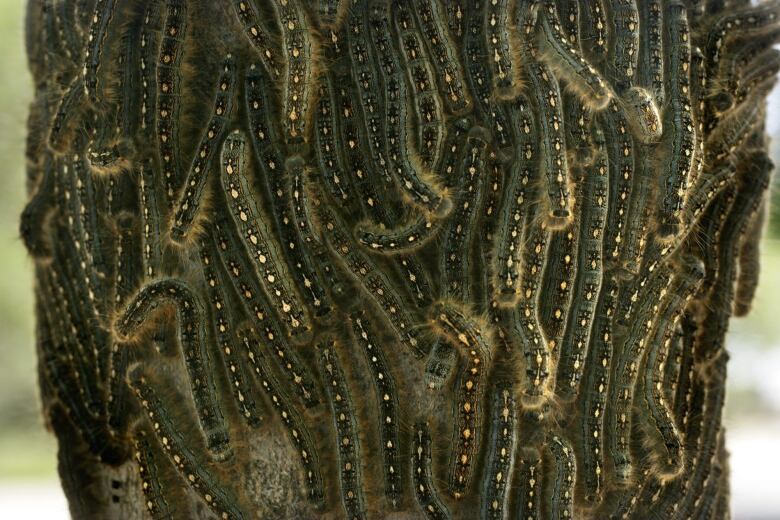5 things to know about forest tent caterpillars
Entomologist Taz Stuart says 500M moths may emerge in July

Forest tent caterpillars are munching their way through Winnipeg, feeding on the leafy canopy of trees.
Forest tent caterpillars typically infest the city once every 10 to 15 years, but when an infestation hits, it can last two to three years. City crews started spraying against the caterpillars two weeks ago.
There are likely more of the wrigglinginsect around the city than most people would expect, Taz Stuart, entomologist and director of technical operations at Poulin's Pest Control Services, said.
He Tweeted on Monday thatif each tree has 100 forest tent caterpillars and there are 5 million trees, 500 million adult moths will emerge in July.
If each tree has 100 forest tent caterpillars and there are ^approx 5 million trees how many adult moth will emerge mid July... 500,000,000!
—@tdtscaTo stop the swarm, he said people can apply contact insecticides such as permethrin, pyrethroid, ormalathionto their trees and that should do the trick.
- Malathion 'probably carcinogenic' to humans, WHO agency concludes
- Malathion supply will not be renewed in Winnipeg after this year
He had some other interesting facts about the creepy crawler.
Caterpillars relaxduring the day
Although it's the time people see them the most, tent caterpillars are actually just relaxing during the day. Stuart said they are most active at night.
"They feed on leaves, they feed at night," he said.
Grouping protects them frompredators
The tent caterpillars might look like they enjoy a good party, clumping together on the trees, but Stuart explained there's a larger purpose to their bunching.
"If they are by themselves a bird might pick them off, or a skunk, a raccoon, even squirrels will sometimes snack on them. When they are a big large clump like that, they usually don't get bugged," he said.
He added there's usually 100 to 150 caterpillars in each clump.

They are equal opportunity tree eaters
While they seem small, the impact of the caterpillars eating away at the leaves can be large. Stuart said the defoliated tree is weakened and slowed down, which means it might not collect enough glucose to create leaves the following year.
"If it gets multiple years of defoliation you could get eventual death of a tree," he said.
Stuart added that he hasn't seen a tree that the caterpillar doesn't like but they prefer ornamentals likeChokecherry and Ash trees. Stuart added he had never seen them in gardens.
Most of their life is spent as an egg
The lifecycle of the tent caterpillar starts as an egg laid approximately in the third week of July, Stuart explained. The eggs sit all winter until the perfect temperatures usually in mid-May.
"They will come out very, very small little larvae. They will go through several increases in size, right now you are seeing pretty much the final stage," Stuart said.
"It will then go to the pupa stage, it's almost like a little cocoon stage that's in the ground or in locations they feel safe to be."
Six weeks later they emerge as moths. Stuart said they are quick to get to mating and laying more egg masses which " look like a little piece of poop on a stick." He said people should destroy those too.
They make an easy pet
The fuzzy, squirmy tent caterpillar can look enticing to young kids to bring home. Stuart said, if that's the case, it's pretty easy for a parent to comply.
"If you want to have them in a nice little container, a couple of leaves from the tree, they will feed on them at night and relax during the day," he said.













_(720p).jpg)


 OFFICIAL HD MUSIC VIDEO.jpg)
.jpg)



























































































